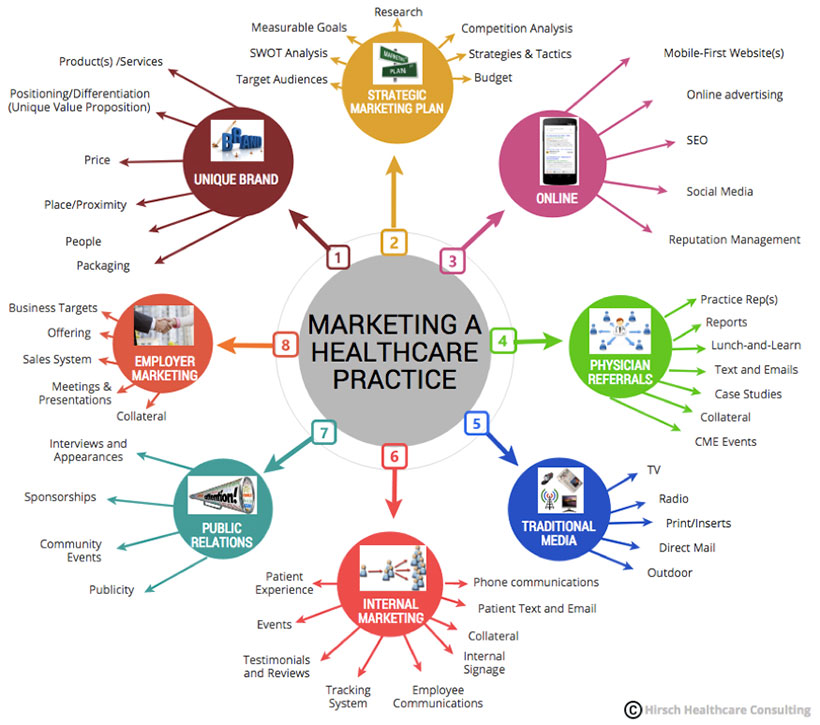The 8 Most Important Marketing Strategies for a Healthcare Practice

In today’s busy, complicated, information-overload, short-attention-span environment, there are hundreds of ways to market a healthcare practice but there are really 8 most important marketing strategies for most healthcare practices.
Each of these 8 strategies includes a host of possible communication tactics. To simplify and organize these strategies and tactics, I have created the infographic featured at the top of this article.
Here is a brief summary of each of the strategies illustrated in this infographic.
Unique Brand
People have so many options today for healthcare services and providers that the only way healthcare practices can truly stand out from the pack of lookalikes is to establish a well-differentiated, memorable and unique value proposition.
The same issue applies to choices available to referring physicians (where applicable).
Your brand is a reflection of your desired reputation and your reputation is, ultimately, your brand. A brand should under-promise and over-deliver.
You and everyone else in your organization is a living, breathing representative and reflection of your brand. The value of your brand is only as good as your commitment and ability to walk your talk – every day in every way.
A healthcare practice brand encompasses the entire patient experience. It is far more than a logo or a website or an ad or any of the elements that may be tools for communication of the value of the brand.
Strategic Marketing Plan
You’ve no doubt heard the saying that originated with French writer Antoine de Saint-Exupery: “A goal without a plan is just a wish.” Truer words were never spoken and they apply as much to success in marketing as in any other endeavor.
Marketing is a business strategy and must be planned as such. Otherwise, you are just shooting blindly in the dark at a target you can’t even see, much less aim at with any accuracy.
Online Presence and Marketing
No one in business needs to be convinced that online strategy is the most powerful difference-maker in the choice of consumers on a wide range of products and services – very much including healthcare.
With that said, the devil is definitely in the details in executing an integrated, interconnected and successful online strategy. In fact, the number of sources of advice, recommendations and online marketing service providers is overwhelming to even the most knowledgeable and marketing-savvy practices.
If you need any further proof that your mobile online presence and your ability to effectively implement online marketing strategies for mobile devices is paramount to your ability to attract more of the patients you really want, look at Google’s new mobile-first index.
Online advertising, SEO, social media and online reputation management are all topics that merit a lot of time, knowledge, experience and expertise. Many healthcare practices prefer to handle this strategy on their own. In almost every case, if you measure success not only by what you get but also by what you fail to get due to lack of sufficient knowledge, experience or expertise, it’s almost never worth it to take a DIY approach to crafting a successful online strategy.
Physician Referral Marketing
Some healthcare practices and specialties do not rely on referrals from other physicians but many medical specialties certainly do.
Ultimately, all referrals, whether from patients, physicians, your own staff or any other source are based on strong relationships. Relationships need to remain active (not passive and presumed by either party) in order to thrive.
We all know how the phrase ends that starts with: “When you assume…”
Referrals from physicians and their staff come from familiarity, trust, confidence, visibility, frequency of contact, empathy, knowledge that the patient will be well taken care of and the timeliness of reports back to the referring physician.
Success in protecting current referral sources and developing new ones is a nurturing process of repeated, proactive contact, illustration of consistent value and keeping both referring physicians and their patients regularly updated on your treatment.
This process is not (or should not be) spontaneous or haphazard. It requires a structured system of commitment, planning, personnel and proactive, frequent communication.
Traditional Media
While online advertising, including Google and other search engines as well as Facebook, YouTube and Instagram is an increasing priority for many practices, traditional media such as TV, radio, print, mail and outdoor advertising all have a potential role to play in attracting new patients for your preferred treatments and services.
Like all other forms of marketing success with traditional media requires a strategy, a game plan.
An unbiased, objective media plan based on your specific goals, target audiences, location, competition and budget is essential to protect your investment (and return-on-investment) in these forms of advertising and promotion.
Sales reps who represent a single media and company are clearly not unbiased. They all have their own “hammer” in search of the next “nail” (you). That should not suggest that their station or publication or program is not potentially a good option for you – as part of a integrated and strategic media plan. But beware the single magic bullet pitch. It may or may not hit your target and if it doesn’t, you have wasted time and money instead of saving both.
There are smart, experienced and unbiased media planners out there. Find and engage one if you want to generate meaningful business from these media.
Internal Marketing
There are many definitions of internal marketing but for most healthcare practices, this category includes communications and advocacy from patients and from the employees of the business.
Internal marketing these days is all about focus on patient experience, including the patient journey, patient satisfaction, patient feedback and patient advocacy. But all businesses, regardless of industry, must consider their employees as another important constituency and major influence on the patient experience.
Internal marketing includes communication with patients both when they are in the office as well as when they are not. Communication when patients are not in the office (which is most of the time) includes:
- phone communications
- text messages and other smartphone communications
- email communications
- patient portal communications
- telehealth consults
- cultivation of patient testimonials (both written and video)
- development of positive online reviews from patients
- mitigation of complaints, negative reviews and other forms of patient dissatisfaction
- in-office signage, videos, collateral
- product displays (e.g., skin care products, optical products, hearing aids, etc.)
- in-office seminars and events for patients
Public Relations
Every practice would like free publicity – as long as it’s positive (which is rarely something you can control). But publicity is only one aspect of public relations and all aspects are important to strengthen and protect your brand and reputation.
In addition to publicity strategies and opportunities, P.R. also includes community events, interviews and appearances, sponsorships and damage control against negative publicity.
Most healthcare practices won’t have a public relations firm on retainer, so public relations for a practice often includes multiple individuals inside and sometimes outside the practice, each with different P.R. responsibilities.
But regardless of who handles P.R. for your practice, there must be a P.R. strategy that everyone adheres to and follows.
Employer Marketing
Clearly, some practices won’t have a reason or wherewithal or priority to actively pursue business from local employers. But opportunities to develop programs for employers and their employees are available to more practices than those who focus on workers comp injuries.
There are already many workplace wellness companies offering and providing workplace wellness programs to employers but these companies do not automatically complete with providers. In fact, many independent providers work with workplace wellness companies to provide health services.
Direct primary care providers are also increasingly focusing on relationships with employers to help them provide additional benefits to employees to mitigate high deductible expenses in company-sponsored health plans.
For any healthcare business that does business providing health services to employers and their employees, a successful strategy must include a well-detailed strategy and marketing plan, including:
- business target llst
- offering (programs, services)
- sales system
- collateral
- meetings and presentations
The Big Takeaways
- Marketing in a healthcare practice has enormous potential to positively influence the financial and reputation health of the practice.
- A goal without a plan is just a wish.
- Most healthcare practices utilize only a fraction of the strategies that represent the potential of marketing to influence profitable growth.
- Effective marketing requires extensive planning and organization.
- Marketing requires more resources (including personnel, money and time) than most practices apply, often resulting in missed opportunities for practice growth and profitability.
- Don’t try to eat the whole elephant in one bite but make consistent progress.
- Marketing is an ongoing, constant enterprise and business system and should not be viewed as a series of periodic or episodic activities and projects.
- DIY is often not the best way to achieve the greatest marketing results and profitability.
- Your brand and reputation is primarily determined by the patient experience.

Your way of telling everything in this paragraph is truly fastidious, all be capable of simply understand it, Thanks a lot.